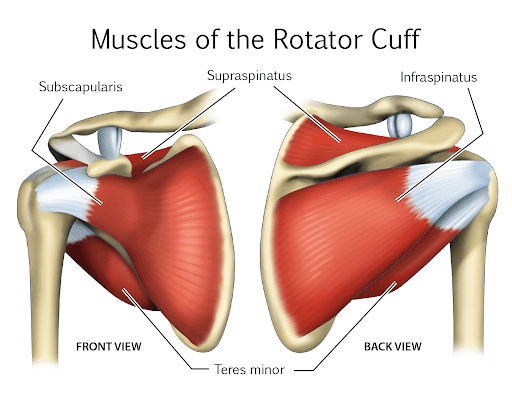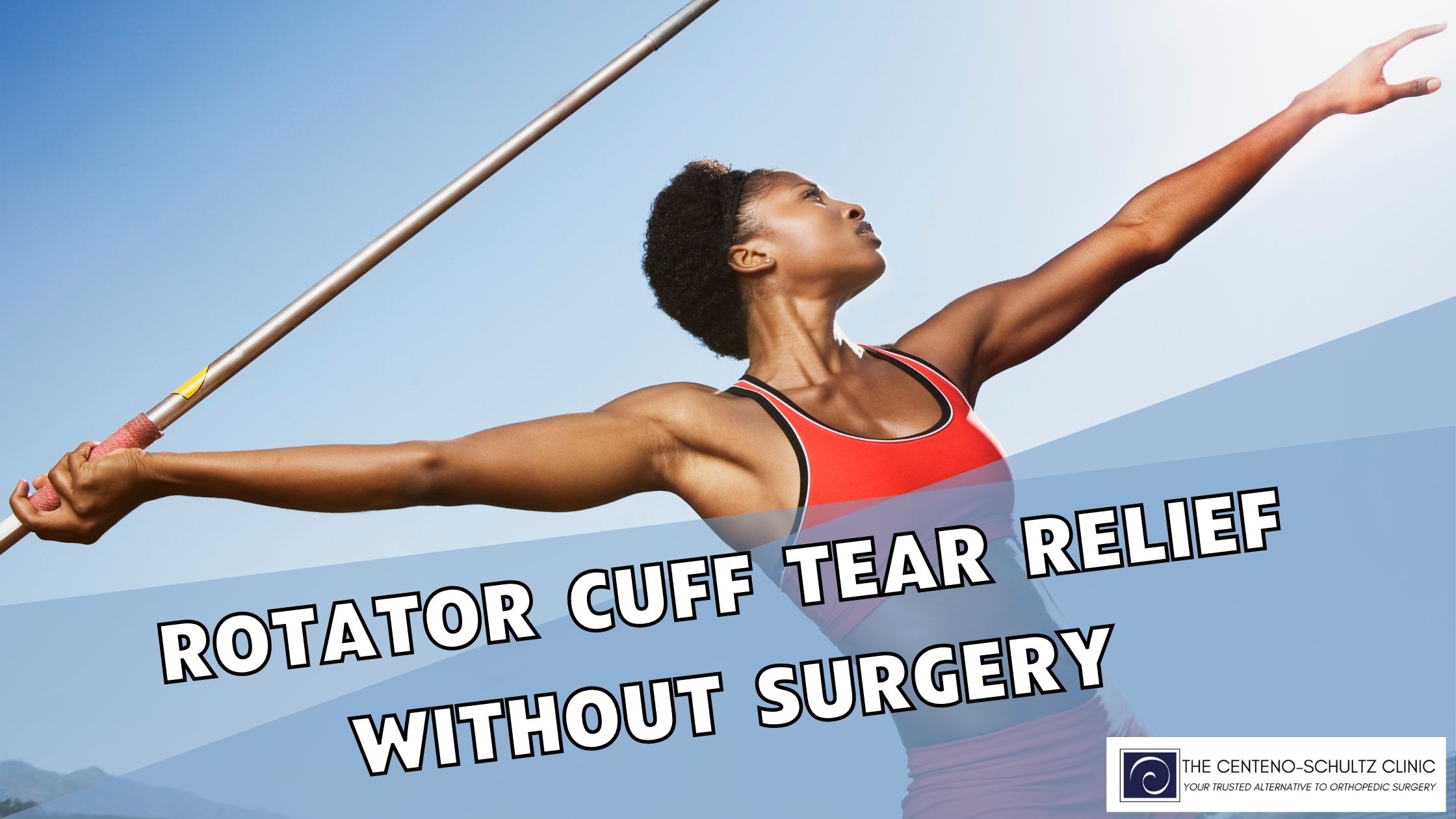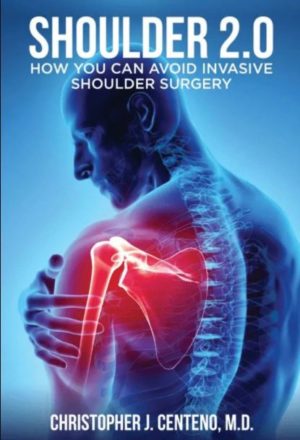Welcome to the Guide for Rotator Cuff Tear Relief Without Surgery. Rotator cuff injuries affect millions of people globally (1). The incidence vastly increases with age. Irrespective of the cause, there are many treatment options for rotator cuff injuries apart from surgery. If you want to avoid rotator cuff surgery, you’re in the right place! Let’s start with the basics.
Learning The Basics Of Rotator Cuff Tears

The rotator cuff comprises four different muscles, one in the front, one on the top, and two in the back. These are the subscapularis, supraspinatus, infraspinatus, and teres minor. Each of these muscles originates on the scapula and inserts on the superior humeral head, and together they help improve the shoulder’s stability.
Rotator cuff tears most commonly occur in the supraspinatus muscle, which is the muscle that helps lift the arm. This is partly because the supraspinatus tendon passes through a narrow space between the humerus and the shoulder’s acromion.
What Are The Specific Types Of Rotator Cuff Tears?
An injury or trauma can lead to a tear in one or more of the rotator cuff muscles. However, there are four main types of rotator cuff tears. They are listed below:
- Tendonitis/tendinopathy: Tendonitis or more appropriately called tendinopathy is fraying or micro tears in the rotator cuff tendon fibers. They are caused by an overload of the shoulder joint with a very high tensile force.
The tears occur when the humeral ball impinges the rotator cuff on the clavicle or AC joint. It can lead to subacromial impingement and bursitis.
- Partial Tear: The next type is a partial tear, where the tendon has tears and is damaged but not fully torn. The tendons in this tear are still attached to bone and are very responsive to physical therapy and injections.
- Full-Thickness Retracted Tear: A full-thickness retracted tear occurs when the tendon is ripped off the bone or the tear spans the entire width of the tendons and the ends do not approximate each other. This is typically presented as shoulder weakness and decreased range of motion. These tears typically require surgery to fix when appropriate.
- Acute Tears: Acute rotator cuff tears are traumatic tears that occur due to an accident, a fall, or when lifting a heavy weight suddenly.
Symptoms Of Rotator Cuff Tears
The following are some of the symptoms of rotator cuff tears. Suppose these symptoms persist for more than a week, even with pain medications, then you must see a doctor.
- Dull shoulder ache: People with a rotator cuff tear typically experience a dull shoulder ache that they cannot pinpoint the exact location of. This is usually the initial symptom of a rotator cuff tear.
- Pain while sleeping or lying on the affected side: When a person lies on the side of the tear, the pain may be aggravated by the pressure on the tear.
- Pain while lifting or lowering the arm: One of the primary roles of the rotator cuff is elevating and depressing the shoulder. A tear in the rotator cuff will affect the ability to lift and lower the shoulder. These movements can become painful due to the tear.
- Weakness: If the rotator cuff is torn, specific shoulder movements may become limited because the shoulder muscles cannot function properly. As a result, the person may experience shoulder weakness.
- Crackling or stiffness while moving shoulder: In some cases, the frayed or torn muscle can become trapped within the joint, or a piece of bone may even come loose in case of prolonged tears, which leads to stiffness and crackling within the joint.
Conservative Rotator Cuff Treatment
Many conservative measures can be taken when a person has been initially diagnosed with a rotator cuff tear. These include the following:
- Activity Modification: Activity modification is the optimization of the biomechanics of the shoulder to help prevent any further impingement or small tears from becoming large tears. This may include Egoscue biomechanical therapy, changing activities, or certain activity modifications.
- Medications: Oral medications, including anti-inflammatories such as ibuprofen, provide short-term relief but have potential side effects. They do so by decreasing inflammatory chemicals that may be affecting the tendons.
Turmeric can cause reduce inflammation with fewer side effects than ibuprofen. If there is any tendonitis of the rotator cuff tendons, then turmeric can lessen the inflammation within them.
- Physical Therapy: Physical therapy can help restore proper shoulder biomechanics, improve shoulder girdle strength, and help decrease impingement. It’s not only for treatment but also can be preventive.
It can also help optimize ergonomics and strengthen the joint to prevent future injuries in the rotator cuff. Typical goals of physical therapy would be to correct the normal motion of the shoulder blades, usually keep them down and back, strengthen the rhomboids, inferior traps, and rotator cuff, and mobilize the pecs and lats..
- Steroid Injections: Steroid injections can temporarily reduce inflammation in the shoulder and alleviate painful symptoms.
However, at the same time, steroids can have a negative effect as they may weaken the tendon, increase the risk of infection, decrease overall cartilage in the joint, and even suppress the release of the body’s adrenal hormones.
What Happens During Rotator Cuff Surgery
If conservative treatments, such as physical therapy and corticosteroid injections, are unsuccessful, the doctors may recommend arthroscopic surgery. This is a procedure where arthroscopic portals (holes) are made in the shoulder joint to fix the rotator cuff.
The procedure is done to increase the size of the joint with fluid, remove parts of the acromioclavicular joint, clip the biceps tendon if needed, place screws into the humerus or metal ball if a prosthesis is used, and then suture the tendon. Afterward, the shoulder is kept immobile in a brace for six weeks.
Another surgical option is an open repair procedure when the tear is large, and a tendon transfer is needed. There is also the option of a mini-open repair, where the surgeon introduces an arthroscope to remove loose bones without detaching the deltoid muscle.
However, all surgeries come with risks, including significant discomfort immediately after the surgery, blood clots, infections, failure of the procedure, and the risks of the anesthesia or nerve blocks themselves. The recovery time can be an average of 9 to 12 months.
The success rate is highly variable depending on the age, general health of the person, and type of tear. A younger patient with a more minor tear has a higher success rate. However, there is an approximately 90% failure rate if the patient exceeds 55 (2).
The Non-Surgical Alternative
Rotator cuff tears can be treated without surgery. Many non-surgical alternatives are available at Centeno-Schultz, including platelet-rich plasma (PRP) and bone marrow concentrate (BMAC).
Our board-certified physicians are experts in musculoskeletal and spinal care with protocols based on our research outcomes for autologous blood platelet-rich plasma and bone marrow concentrate that includes cells to help your shoulder improve.
All our patients receive a lengthy one-on-one consultation with our physicians. Each patient also receives a diagnostic ultrasound and x-rays, and/or MRI imaging can be ordered as needed to review and determine the best treatment option. Patients can then make informed decisions about how to proceed with the treatment. The following outlines the non-surgical alternatives we offer for rotator cuff tears:
Platelet-Rich Plasma (PRP)
Platelet-rich plasma has excellent outcomes for tendinitis/tendinopathy and small partial rotator cuff tears. Here, patients are injected with their platelet-rich plasma which contain growth factors. PRP stimulates the proliferation of fibroblast cells that lay down collagen and tendon fibers.
The results of PRP are long-term, helping patients decrease pain and improve function. THere are several high quality randomized controlled trials that demonstrate PRP’s effectiveness for rotator cuff problems over steroids, saline, and physical therapy Orthopedic Bone Marrow Stem Cell Historical Timeline (regenexx.com).
Bone Marrow Concentrate
For some of the larger partial tears or full-thickness tears without retraction, bone marrow concentrate has good outcomes, as evidenced by some of our publications. CSC has also done a research study. We enrolled patients for the bone marrow concentrate rotator cuff tear treatment. The mid-term analysis of the study has been published in a peer-reviewed journal (3).
There were no serious adverse events or complications with this treatment. The patients had successful treatment outcomes and allowed the participants to return to functional activity once the treatment was completed. Patients reported average subjective improvements of 89% at 2 year and there was also also MRI evidence of healing.
Another option is the bone marrow concentrate culture expansion procedure. Board-certified physicians at Centeno-Schultz Clinic can perform this procedure in the bone marrow culture expansion at our Grand Cayman-licensed medical clinic.
The doctor aspirates bone marrow cells just as done in the U.S, but then the mesenchymal stem cells (MSCs) are isolated and grown to 100 to 1000x more cells. These stem cells are then injected into the rotator cuff. This can provide a more powerful healing punch to repair torn rotator cuff tendons.
Explore The Alternatives To Rotator Cuff Surgery
Rotator cuff tears can be life-altering and debilitating. At Centeno-Schultz Clinic, we offer alternatives to surgery, helping patients avoid lengthy rehabilitation and potential surgical complications.
Our clinicians use PRP and bone marrow concentrate to stimulate the body’s healing response. No one should feel shoehorned into surgery when there are better options available. If you or someone you know has been recommended rotator cuff surgery, contact us for a second opinion.
Are you a Candidate?
References
- Sambandam SN, Khanna V, Gul A, Mounasamy V. Rotator cuff tears: An evidence-based approach. World J Orthop. 2015;6(11):902-918. Published 2015 Dec 18. doi:10.5312/wjo.v6.i11.902
- Kurowicki J, Berglund DD, Momoh E, et al. Speed of recovery after arthroscopic rotator cuff repair. J Shoulder Elbow Surg. 2017;26(7):1271-1277. doi:10.1016/j.jse.2016.11.002
- Centeno C, Fausel Z, Stemper I, Azuike U, Dodson E. A Randomized Controlled Trial of the Treatment of Rotator Cuff Tears with Bone Marrow Concentrate and Platelet Products Compared to Exercise Therapy: A Midterm Analysis. Stem Cells Int. 2020;2020:5962354. Published 2020 Jan 30. doi:10.1155/2020/5962354

